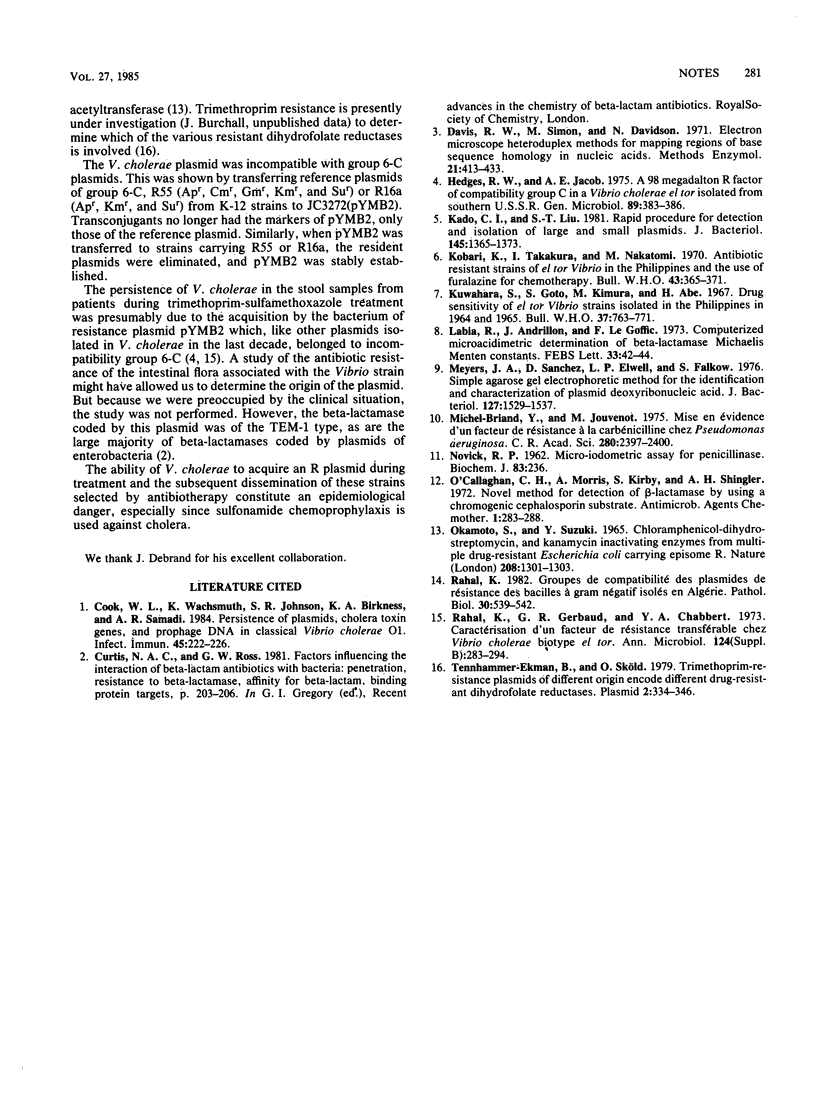Abstract
The persistence of Vibrio cholerae, biotype el tor, in a patient treated with trimethoprim-sulfamethoxazole was due to the acquisition of a conjugative resistance plasmid. The plasmid, with a molecular size of 72 megadaltons, belonged to incompatibility group 6-C and conferred resistance to ampicillin, chloramphenicol, sulfonamide, and trimethoprim.
Full text
PDF

Selected References
These references are in PubMed. This may not be the complete list of references from this article.
- Cook W. L., Wachsmuth K., Johnson S. R., Birkness K. A., Samadi A. R. Persistence of plasmids, cholera toxin genes, and prophage DNA in classical Vibrio cholerae O1. Infect Immun. 1984 Jul;45(1):222–226. doi: 10.1128/iai.45.1.222-226.1984. [DOI] [PMC free article] [PubMed] [Google Scholar]
- Hedges R. W., Jacob A. E. A 98 megadalton R factor of compatibility group C in a Vibrio cholerae El Tor isolate from southern U.S.S.R. J Gen Microbiol. 1975 Aug;89(2):383–386. doi: 10.1099/00221287-89-2-383. [DOI] [PubMed] [Google Scholar]
- Kado C. I., Liu S. T. Rapid procedure for detection and isolation of large and small plasmids. J Bacteriol. 1981 Mar;145(3):1365–1373. doi: 10.1128/jb.145.3.1365-1373.1981. [DOI] [PMC free article] [PubMed] [Google Scholar]
- Kobari K., Takakura I., Nakatomi M., Sogame S., Uylangco C. Antibiotic-resistant strains of E1 Tor vibrio in the Philippines and the use of furalazine for chemotherapy. Bull World Health Organ. 1970;43(3):365–371. [PMC free article] [PubMed] [Google Scholar]
- Kuwahara S., Goto S., Kimura M., Abe H. Drug-sensitivity of El Tor vibrio strains isolated in the Philippines in 1964 and 1965. Bull World Health Organ. 1967;37(5):763–771. [PMC free article] [PubMed] [Google Scholar]
- Labia R., Andrillon J., Le Goffic F. Computerized microacidimetric determination of beta lactamase Michaelis-Menten constants. FEBS Lett. 1973 Jun 15;33(1):42–44. doi: 10.1016/0014-5793(73)80154-1. [DOI] [PubMed] [Google Scholar]
- Meyers J. A., Sanchez D., Elwell L. P., Falkow S. Simple agarose gel electrophoretic method for the identification and characterization of plasmid deoxyribonucleic acid. J Bacteriol. 1976 Sep;127(3):1529–1537. doi: 10.1128/jb.127.3.1529-1537.1976. [DOI] [PMC free article] [PubMed] [Google Scholar]
- Michel-Briand Y., Jouvenot M., Roche J. Mise en évidence d'un facteur de résistance à la Carbénicilline chez Pseudomonas aeruginosa. C R Acad Sci Hebd Seances Acad Sci D. 1975 May 26;280(20):2397–2400. [PubMed] [Google Scholar]
- NOVICK R. P. Micro-iodometric assay for penicillinase. Biochem J. 1962 May;83:236–240. doi: 10.1042/bj0830236. [DOI] [PMC free article] [PubMed] [Google Scholar]
- O'Callaghan C. H., Morris A., Kirby S. M., Shingler A. H. Novel method for detection of beta-lactamases by using a chromogenic cephalosporin substrate. Antimicrob Agents Chemother. 1972 Apr;1(4):283–288. doi: 10.1128/aac.1.4.283. [DOI] [PMC free article] [PubMed] [Google Scholar]
- Okamoto S., Suzuki Y. Chloramphenicol-, dihydrostreptomycin-, and kanamycin-inactivating enzymes from multiple drug-resistant Escherichia coli carrying episome 'R'. Nature. 1965 Dec 25;208(5017):1301–1303. doi: 10.1038/2081301a0. [DOI] [PubMed] [Google Scholar]
- Rahal K., Gerbaud G. R., Chabbert Y. A. Caractérisation d'un facteur de résistance transférable de Vibrio cholerae biotype eltor. Ann Microbiol (Paris) 1973 Oct;124(3):283–294. [PubMed] [Google Scholar]
- Rahal K. Groupes de compatibilité des plasmides de résistance des bacilles a Gram négatif isolés en Algérie. Pathol Biol (Paris) 1982 Jun;30(6 Pt 2):539–542. [PubMed] [Google Scholar]
- Tennhammar-Ekman B., Sköld O. Trimethoprim resistance plasmids of different origin encode different drug-resistant dihydrofolate reductases. Plasmid. 1979 Jul;2(3):334–346. doi: 10.1016/0147-619x(79)90017-9. [DOI] [PubMed] [Google Scholar]


